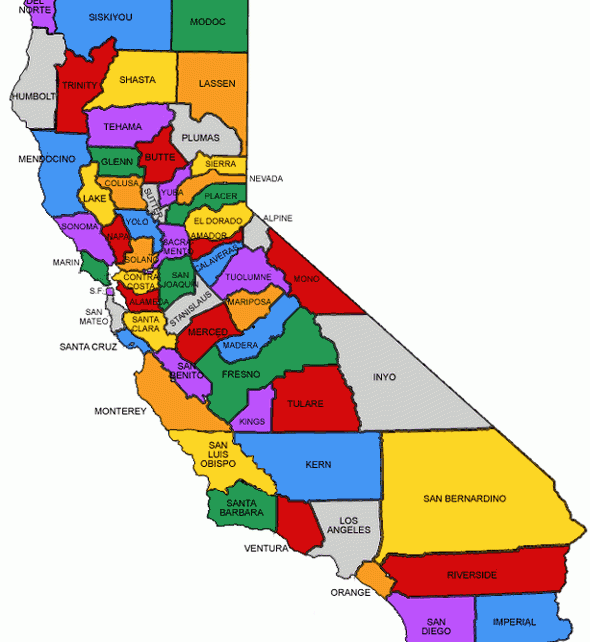
Have you ever wondered how many counties California actually has? You’d be surprised how many people ask the same question. Be it for research, a road-trip map, or pub-quiz glory, the number 58 keeps popping up, butthat short answer barely scratches the surface.
The Golden State’s 58 counties createa patchwork of contrasts: fog-kissed seaside towns, pine-covered mountain regions, fruit-laden interior valleys, and global entertainment capitals. None of these counties lacks a unique backstory, shaped byimmigration waves, high-tech revolutions, and relentless population booms.
In the sections ahead, we’ll dig intohow the state’s county map froze at fifty-eight, the services counties deliver day-to-day, and which ones stand out for size, population, or sheer quirkiness. When we’re done, you’ll own the knowledge—and map your next California adventure with confidence.
How the Golden State Reached 58 Counties
On statehood day in 1850, the map contained barely half the jurisdictions we know now. An unprecedented population boom compelled legislators to carve out new counties. By the end of the 1870s, the count had risen to 53 counties, and that same year the last adjustments were ratified, cementing the canonical figure of 5 8.
Legislative records show that most new counties were born because of a trio of factors:
- Hundreds of rugged miles made court access impossible.
- Tax disputes splitting river towns from hinterlands sparked break-ups.
- Cultural rivalries demanded tailored governance.
In less than seventy years, the political map hardened. In modern times, even bold secession schemes rarely get ballot traction, prompting analysts to call the era when new counties sprouted a finished chapter.
From Kelp Forests to High Deserts: County Geography
Plot a route from rugged Del Norte on the Oregon line to the date groves of Coachella, and you’ll traverse dozens of ecosystems. Ocean-brushed jurisdictions enjoy Mediterranean precipitation, while interior giants like San Bernardino or Kern bank on irrigation.
- Alpine districts such as Mono, Mariposa, and Calaveras host ski resorts.
- River-delta territories mix levee farms with wetlands.
- Off-shore authorities like Ventura manage marine sanctuaries.
This breadth clarifies how how many county in california water rights, zoning, and ag yields diverge so sharply. Weather sets tax bases and lifestyles.
Behind the Scenes at the County Level
In California’s layered structure, cities tackle local bylaws, but counties shoulder vital “unseen” duties that hold civilisation together. Life’s paperwork trail—marriage licenses, tax rolls, voter registries—all reside at the county clerk or recorder.
Sheriff’s departments patrol towns too small for police forces, while superior courts hear civil suits. Social-services bureaus coordinate Medi-Cal. Budget battles occur in monthly Board of Supervisors sessions.
Spotlight: Los Angeles County’s Scale
Los Angeles County alone employs 100 000+ workers, showing how elastic county governance proves. There’s no single blueprint when populations range from under 1 200 to over 10 million.
In the end, county halls translate state statutes into daily action. Knowing their role guides newcomers navigating paperwork.
Where the People and Money Are
The state shelters over 39 million residents, but that population collects in dramatic clumps. Los Angeles County alone accounts for roughly a quarter. On the flip side, tiny Alpine County could fit its voters into a high-school gym.
- Top headcount: Los Angeles
- Fewest people: Alpine
- Largest area: San Bernardino County
- Tightest borders: San Francisco
Economically, the disparities are just as sharp. Silicon Valley counties boast per-capita GDP rivaling small nations, while cotton-and-almond hubs face commodity price swings. These fiscal contrasts drive school funding debates every decade.
Tracking each superlativemakes relocation plans simpler: county borders redraw home-buying budgets and business licences.
The Ultimate California County Circuit
County-collecting hobbyists, setting foot in each CA county ranks as a top geo-challenge. A popular itinerary sets out in the south-west corner, heads north along Highway 1, swings through Big Sur, then threads through nut groves and tomato fields, before climbing into the high Sierra for old stamp mills.
Breaking the Trip Into Segments
- South-land Loop – San Diego to Santa Barbara; a baker’s dozen of stops in three days.
- Valley Ribbon – Bakersfield up to the delta; eight hours of orchards.
- Northern Peaks – mountain lakes and volcano cones; hidden hot springs.
Finish the circuit in the desert southeast, having logged 1 400–2 000 miles. After that, you can confidently claim you know “how many counties California has”—because your copyright stamps prove it!
Frequently Asked Questions
Wondering how the county system works? Start with these quick answers.
How many counties does California have?
California officially recognises fifty-eight counties—no more, no fewer. Regardless of the source—be it Sacramento archives or federal census data: precisely fifty-eight.
Which county has the largest population in California?
The population heavyweight is Los Angeles County, hosting a population greater than that of many U.S. states. From Hollywood to high tech, a mix of industries continues to fuel steady inflow.
Least populous California county?
The crown for smallest population goes to Alpine County, rarely crossing the 1 200-resident mark. Its remote Sierra setting limits large-scale development, making it a haven for solitude seekers.
Largest county by land size?
Geographic titan San Bernardino County stretching more than 20 000 square miles. Its sheer scale means climate zones shift from alpine snow to Mojave heat within county lines.
Why does California have exactly 58 counties?
Early statehood growth pressures split larger districts into smaller units, wrapping up after Imperial broke from San Diego in the early 20th century. Every modern effort to create a new county stalls in committee or dies at the ballot box.
Is it possible to form a 59th county?
Legally, yes—state law allows it, though the process is arduous. Petition drives, feasibility studies, dual-county referenda, and a two-thirds vote in Sacramento make secession rare. That’s why no county lines have moved since the early 1900s.
Why are counties important to everyday life?
County governments deliver core public services: voter registration, deed recording, health clinics, and sheriff patrols. Without county infrastructure, everything from jury duty to restaurant inspections would grind to a halt.